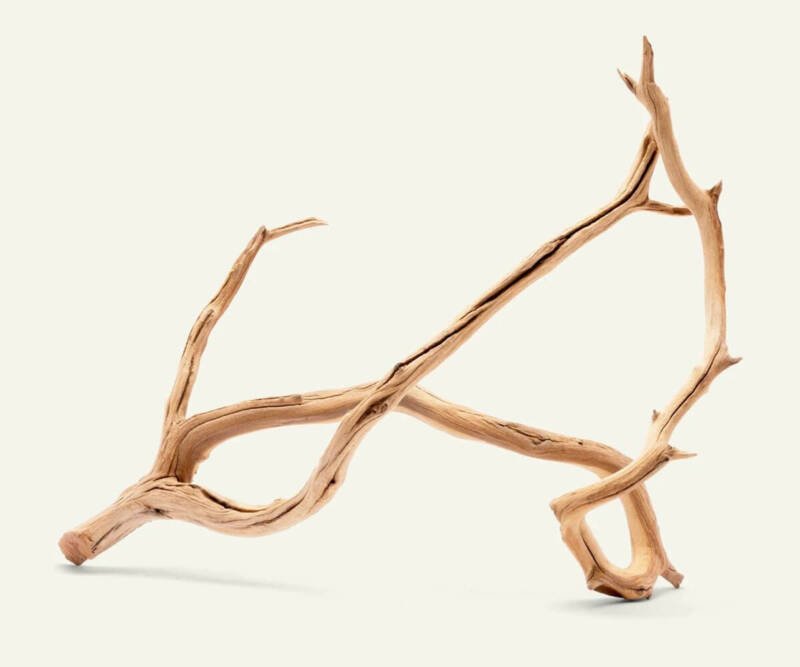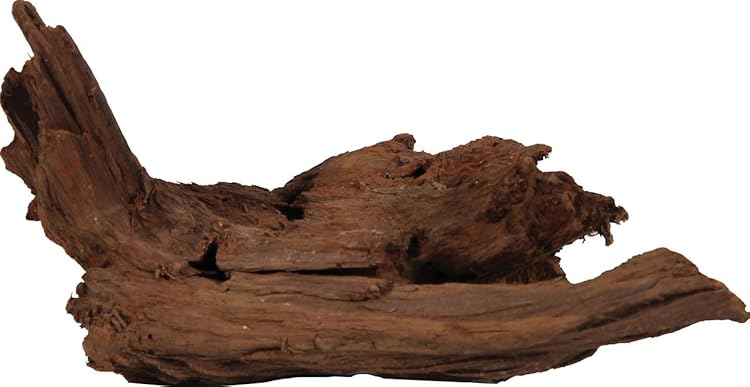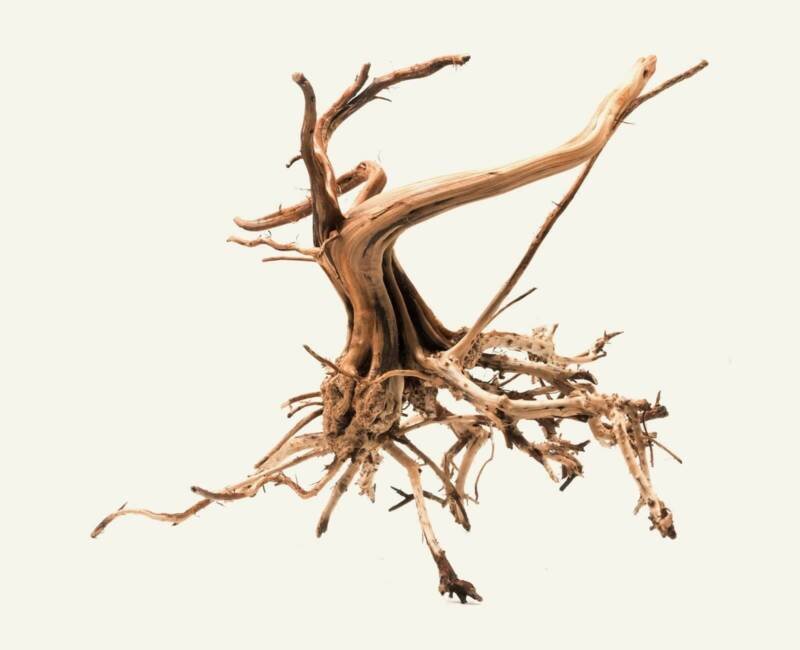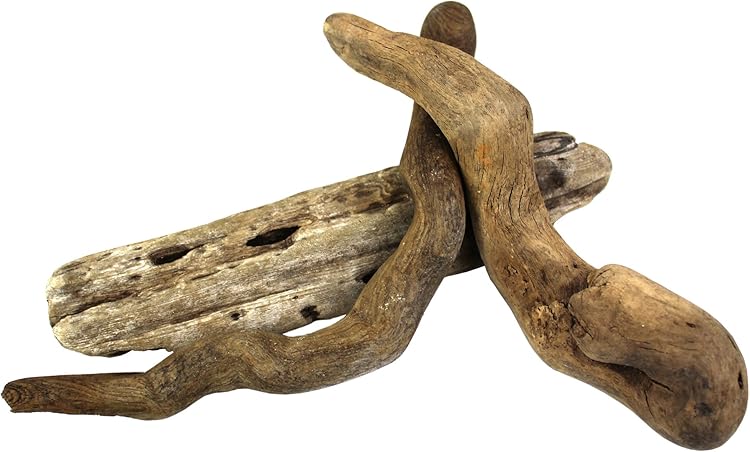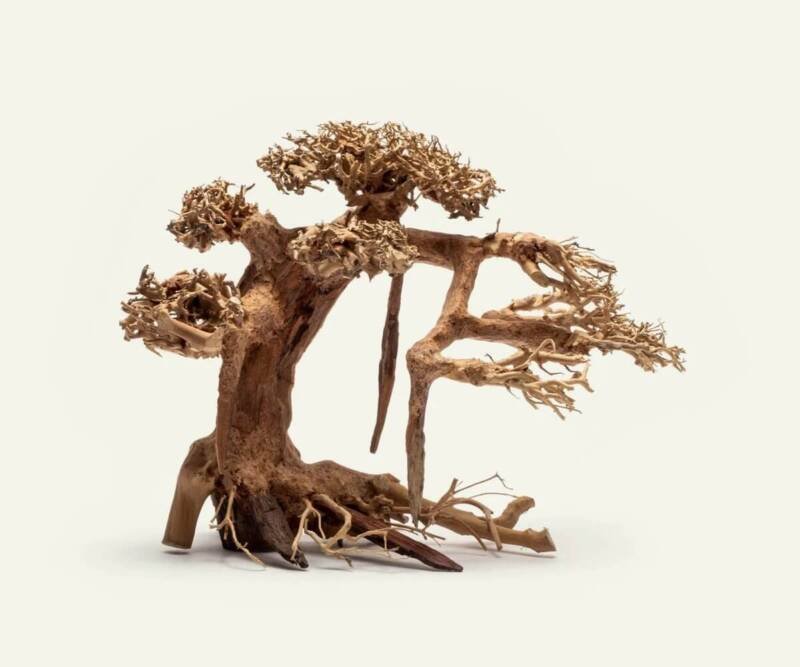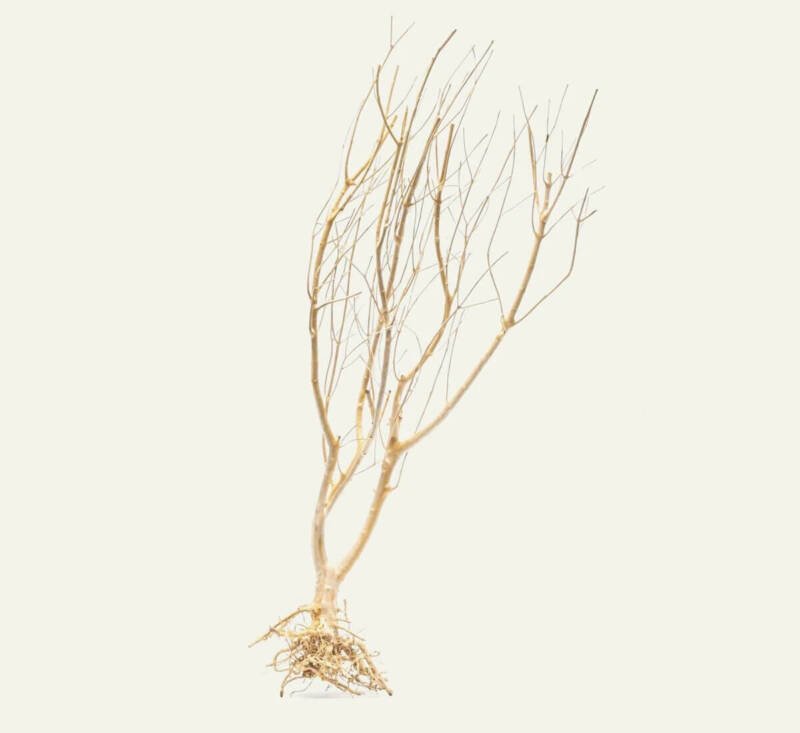Aquascaping your freshwater aquarium is both decorative and functional.
You want an attractive-looking aquarium in your home or office that everyone will enjoy looking at. Your fish will also make use of the underwater landscape for exploring, feeling safe, and hunting for food.
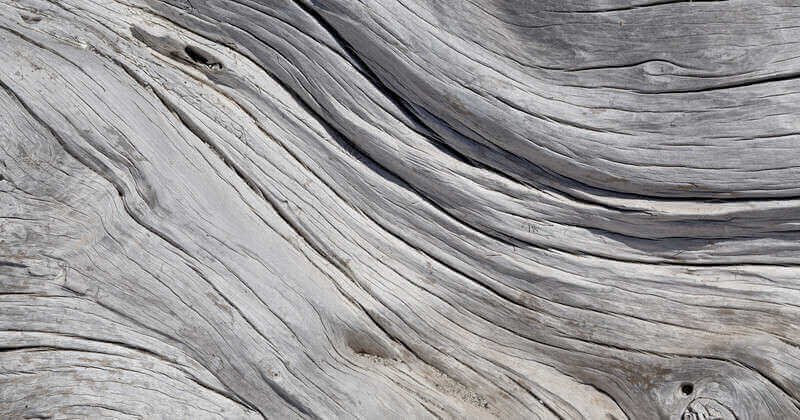
We often think of live plants as the primary type of material for aquascaping. But when you want to bring the look of your freshwater aquarium to the next level, nothing does it like driftwood.
If you remember a childhood aquarium or even been active in the hobby for a long time, you probably recall the relatively basic-looking brown driftwood used to decorate aquariums. Those days are over now – a variety of wood decorations is available to fish keepers.
There are more shapes, colors, and textures than ever. You can even use certain domestic tree wood for aquascaping. But not every type of wood is safe for the aquarium.
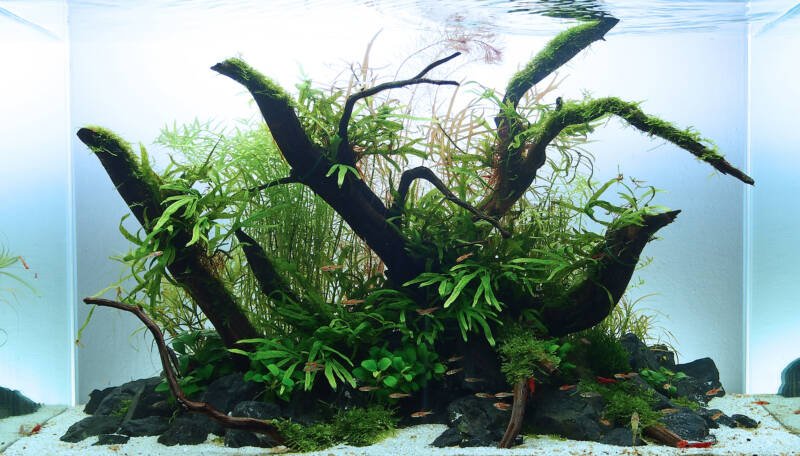
We’ll look at the art and science of using driftwood in a freshwater aquarium. Once you know the basics, you’ll be able to create an underwater aquascape that’s sure to impress.
In this article
What is driftwood?
Driftwood is the remains of trees and bushes washed into the ocean, lake, or river. The wood eventually loses its bark due to decay and the physical action of waves, wind, and tides.
But not all driftwood comes from the water.
Some wood simply weathers over the years, sitting on the shore. Some types of wood sold for aquariums come from the desert and have never been submerged or soaked with water.
Today aquarium driftwood means a variety of natural wood types suitable for use in fish tanks.
Why use driftwood in an aquarium?
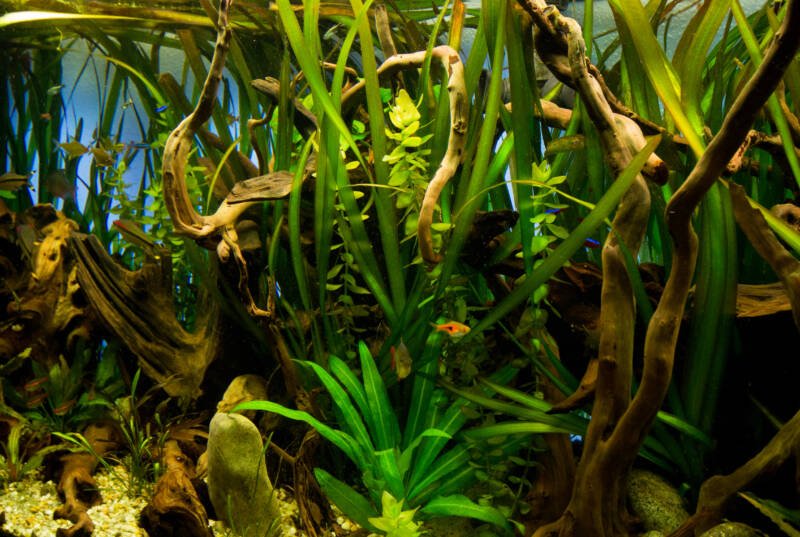
Decorating with natural wood transforms an aquarium from a basic glass box into a three-dimensional underwater world.
A piece of wood draws the eye and creates a strong accent piece that sets the aquascape style. The wood may have a delicate root-like shape or a chunky log-like appearance.
But there’s more to it than just looking good. Driftwood provides a more natural habitat for freshwater fish and shrimp.
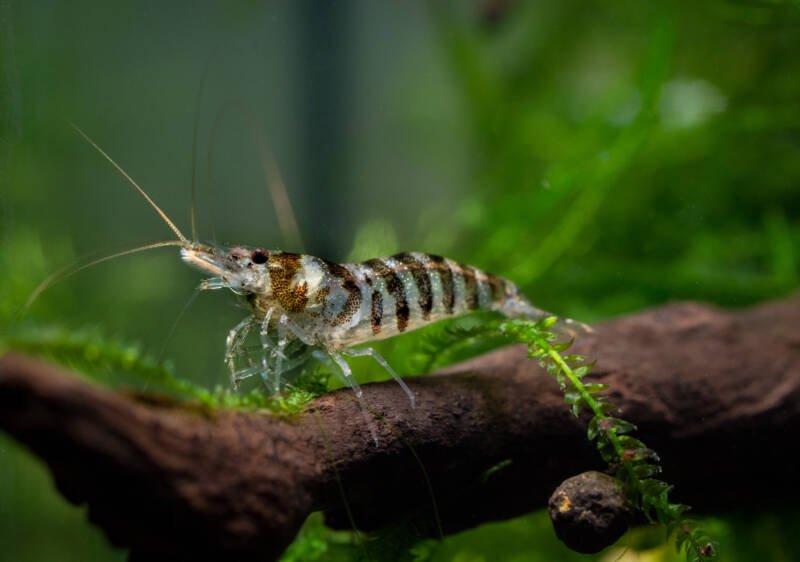
The wood creates secluded spaces to explore or hide in.
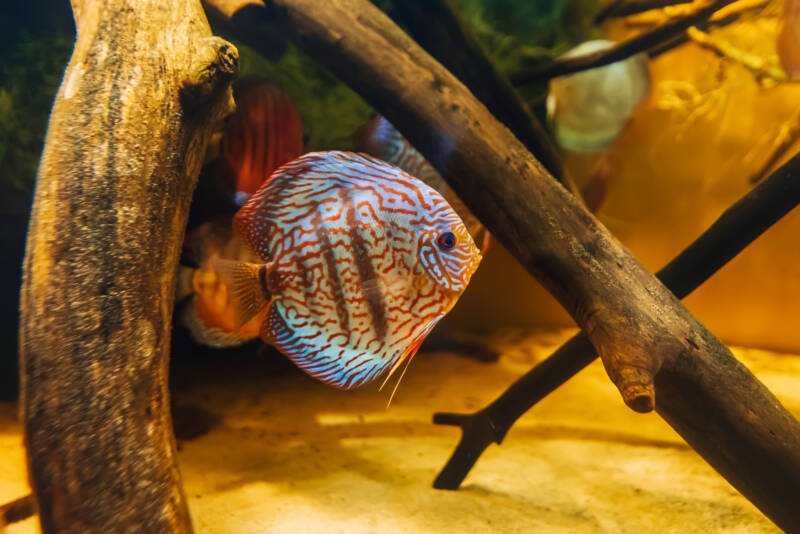
Egg-laying fish often seek out a place to spawn. Some fish will lay eggs directly on the wood.
Others will excavate a pit near the base. It can even give the fry a “home base” to swim to if they sense other fish are getting too close.
The surface of driftwood is an ideal place for the development of algae and microbes.
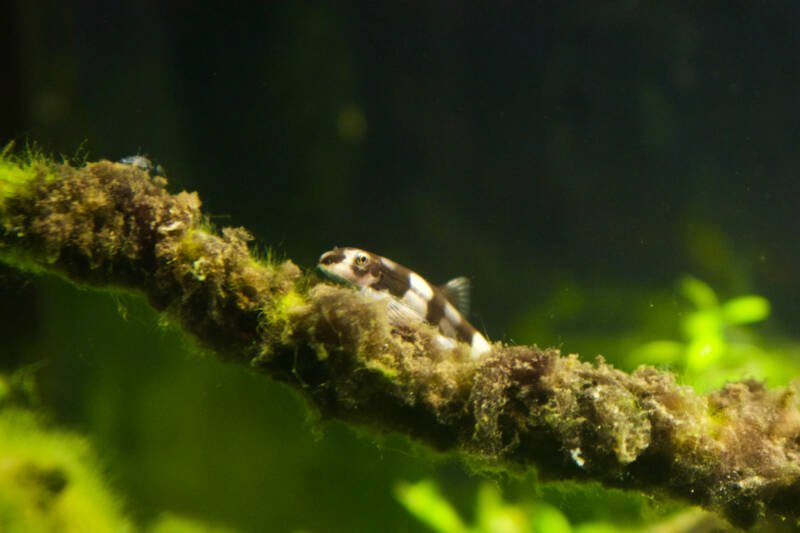
Why would you want algae growth? Many fish thrive by grazing on this microscopic food source. Known in German as aufwuchs or “surface growth,” this thin layer of live food is what many tropical fish eat in nature.
Certain pleco catfish are believed to also scrape off and eat pieces of driftwood. This is called Xylophagy and appears to be unique to Panaque catfish like the red-eyed pleco.
But all aquarium fish will enjoy an aquascape containing driftwood, whether they peck on the wood or not.
Types of driftwood safe for aquarium
Several types of driftwood can be used in the aquarium. But to be clear, not all wood has to be real driftwood.
In fact, most decorative wood sold for aquariums has never sat for years weathering on the side of a river or soaked in a bog. But that doesn’t mean the wood can’t be used in your aquarium.
Many types of driftwood look great and are completely safe for your fish, frogs, snails, shrimp, and other aquatic life.
Some types of wood will release tannins into the aquarium water. The tannins are stored in the branches’ bark and wood, protecting the plant from natural plant pathogens.
Tannins tend to give the aquarium water a tea-like color. Some aquarists find this appealing since it duplicates Amazonian “blackwater” rivers.
But sometimes wood can release a lot of tannins and cause the water to become very dark. It won’t harm the fish, but it can be distracting. Have a look at our blackwater aquarium guide!
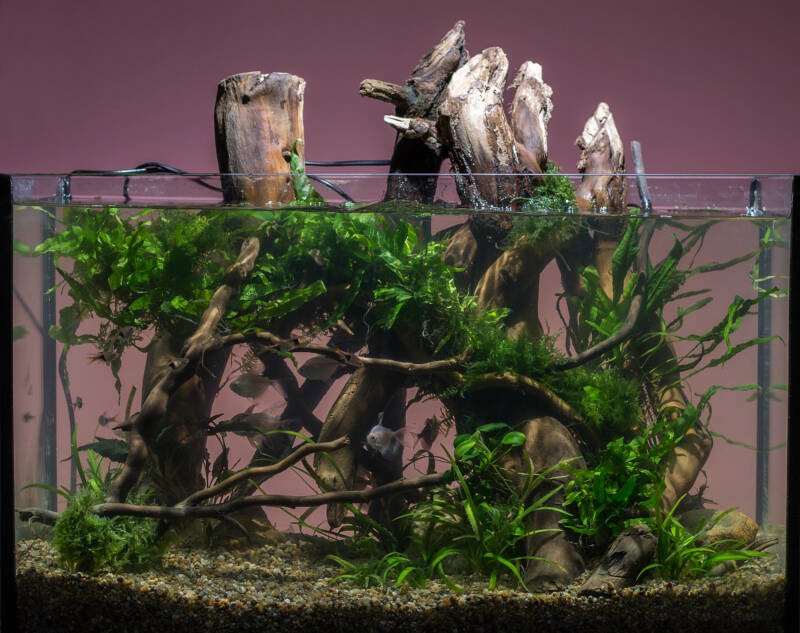
We’ll explain how to prepare and cure driftwood for the aquarium later.
Here’s a breakdown of the most common types of aquarium wood you can find online and in fish shops. Keep in mind that some types of wood are generic descriptions and not specific species.
1. Sumatran Driftwood
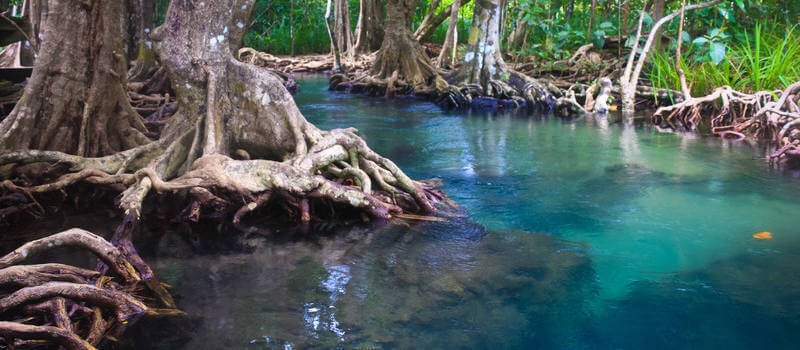
Sumatran driftwood is actually pieces of mangrove roots. They’re harvested from dead mangrove trees during land clearing.
Rather than burn or discard them, the roots are sandblasted to remove the bark. It gives the wood a smooth, appealing look.
It appears rather large and is typically used in big freshwater aquariums as a centerpiece.
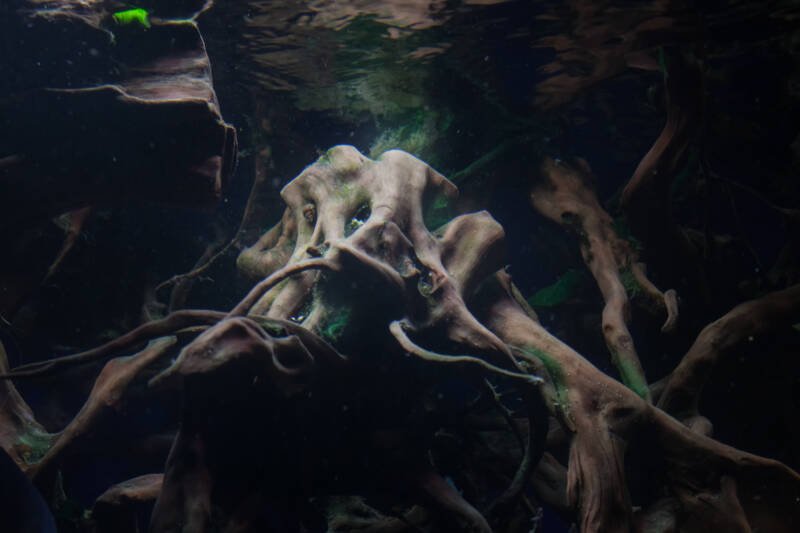
Sumatran driftwood is not known for releasing tannins or discoloring the water. Aquarists report that some pieces will float if not put through a curing process.
2. Bogwood
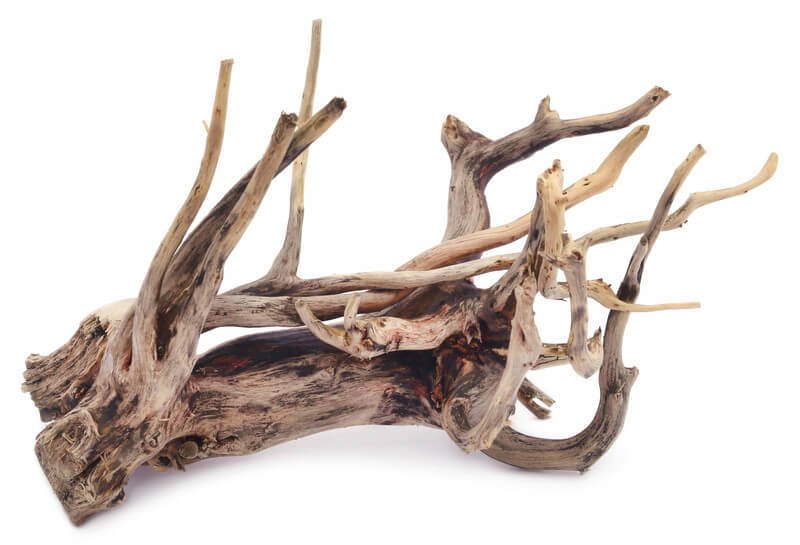
The aquarium trade used to see true bogwood. This was wood that was submerged underwater for years. The idea was to take submerged wood from natural water and recreate the aquatic biotope in the aquarium.
It’s hard to find true bogwood in aquarium shops today. Modern bogwood is actually a variety of dried and weathered wood products cut to fit inside aquariums. Some pieces are screwed onto a heavy piece of slate.
The slate base is covered with aquarium gravel. This serves to stabilize the piece of wood and prevent it from floating.
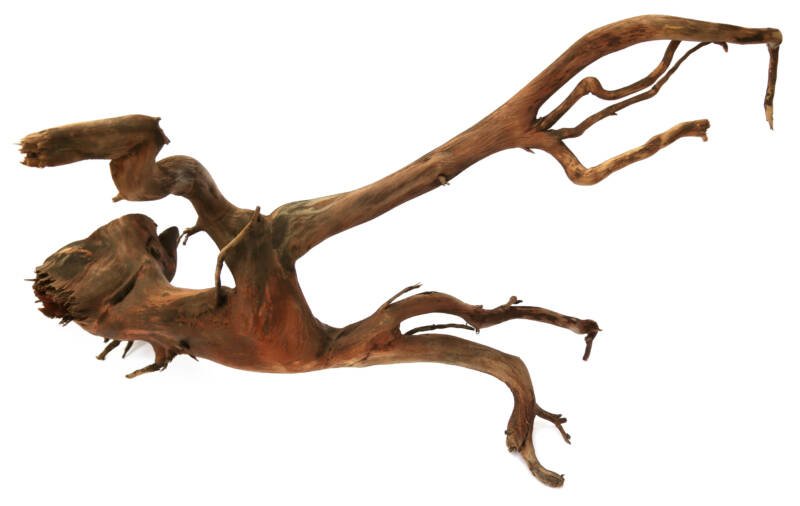
Bogwood is a favorite because it is easy to work with, looks like a submerged stump or branch, and looks nice in just about many aquascape designs.
It’s also simple to get java fern, Anubias, and mosses to attach and cover bogwood.
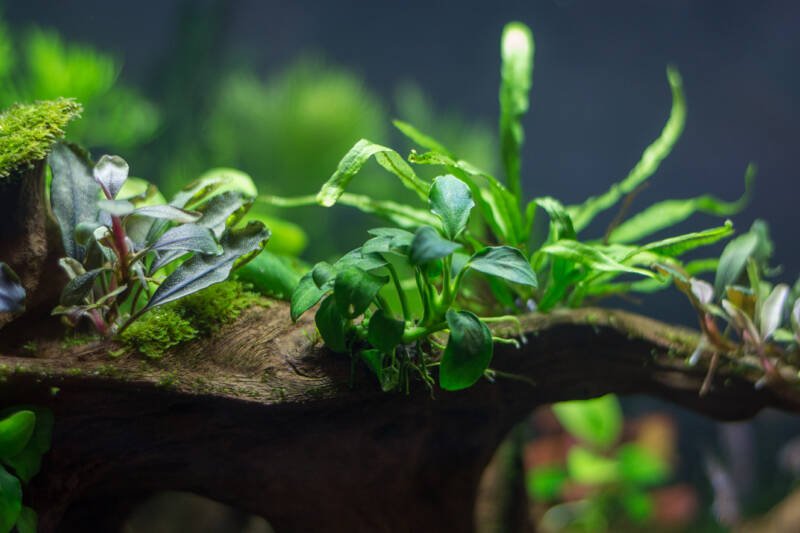
You may need to soak smaller, non-weighted pieces of bogwood to get them to sink.
Bogwood is famous for leaching tannins into the water. You never know how much a piece of bogwood will release. That’s why curing it is important.
3. Mopani Wood
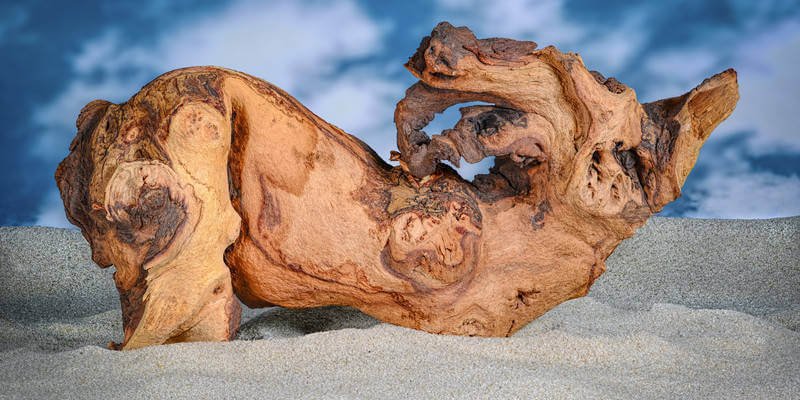
This wood has a unique heavy club-like appearance. The wood is sand-colored with darker markings. It’s fairly common in online and retail shops.
The Mopane tree is native to South Africa, Botswana, and Namibia.
It’s no secret this wood has never been soaked in a bog or river! The tree will grow quite large in good soil, but in sandy soil with poor nutrients, the Mopane tree looks more like a shrub. That’s the form most often seen in the aquarium.
Mopani wood is very dense and heavy. It should sink quite readily. But Mopani will also release tannins into the aquarium. Many aquarists recommend thorough curing before adding this wood to your aquarium.
4. Marsh Root
This driftwood is popular in Europe and is sometimes available in North America. The wood has been thoroughly soaked and aged underwater.
It won’t release tannins or discolor the aquarium water. Marsh root has a very dark color and looks best with a light-colored gravel substrate. It provides a striking centerpiece to the aquarium.
5. Cholla Wood
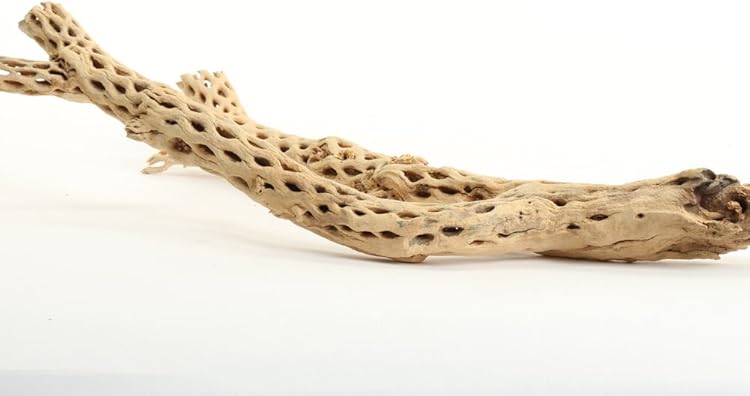
Cholla, native to the Southwest United States, is a large, upright cactus that grows to a height of 13 feet. This cactus is also known as the “walking stick.”
When alive, the cactus is very prickly, being covered with barbed white to green spines. But when the plant dies and dries out, it leaves behind a wooden tube. The woody tube is tan to brown and is full of holes.
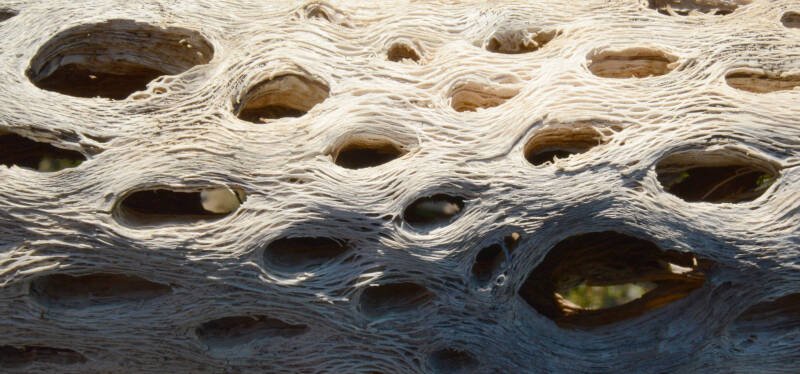
Cholla wood is a favorite for use in shrimp tanks.
The Cholla surface develops a living biofilm that shrimp will feed on. The hollow tube and holes make an excellent place for shrimp to hang out while molting. Small fish will also like to explore this unique type of aquarium wood.
Cholla is a soft wood that releases tannins into your water and should be cured before use if you are concerned about color. Cholla may also need to be soaked to make it sink in the aquarium. (More at Amazon)
6. Redmoor Root Wood
Redmoor root wood looks like someone pulled up a small tree stump along with the roots. And that’s exactly why aquarists love it.
The tangle of delicate roots looks just like tree roots coming from a riverbank. Redmoor root instantly creates a dense tangle of miniature roots that fish love to explore. It creates a true three-dimensional focus point to the aquarium.
The wood has a reddish tint that adds a subtle vibrance to the aquascape without drawing too much attention to itself.
Redmoor root wood tends to float. Some pieces become water-logged after two weeks of curing. Some take even longer. But the wait is worth it!
Manzanita wood is a generic term for various evergreen shrubs native to Oregon, Texas, California, and New Mexico.
The branches are more delicate and look like roots when used underwater. This hardwood lasts for years and resists rotting.
The bark is reddish, but some sandblasted aquarium Manzanita looks tannish. It does not leach tannins but may need curing to help it sink.
8. Jangle Wood
Jangle Wood looks like a combination of branched driftwood and stump. It’s often attached to a piece of slate to keep the stump upright.
Jangle Wood can have a dark color or a bleached appearance. It’s best suited for wider aquariums as a centerpiece. It won’t leach tannins.
Spider Wood, also known as Chinese Azalea Wood, looks just like its name. The wood has a central body with long spider-like branches.
It’s a light-colored wood that looks good in any aquarium style. Spider Wood tends to be large, but it can be easily trimmed to fit a smaller tank. (More at Amazon)
Malaysian driftwood is a popular wood for freshwater aquariums. It comes in various shapes and sizes, allowing you to create a natural environment that your fish and plants will love.
It’s easy to wrap the wood with moss or place a clump of Buce onto it. Conditioning is suggested to reduce the release of tannins and help the wood sink. (More at Amazon)
This driftwood has a pale tan appearance. Every piece is different in size and shape. Tiger Wood is highly branched but not thin or spidery.
Most pieces sold for aquariums are large or extra-large. You can attach ferns and mosses quite easily to this type of wood.
Pacific Wood looks similar to Malaysian driftwood. It has a similar texture and surface to Malaysian driftwood but with many more knots, tangles, and complex characters.
Pacific Wood comes in a variety of sizes and shapes for any size aquarium. (More at Amazon)
13. Saba Wood
Saba Wood is a deep, vibrant brown color. It also has a stunning subtle streaking throughout the wood.
Saba wood has a smooth, almost buffalo horn-style texture. Most of the wood sold for aquariums looks like a stump with little branching.
This is a specialty aquascaping wood created by combining various woods into one piece of “art.” The result is a single piece of driftwood that resembles a bonsai tree.
Bonsai is the art of pruning a tree, so it stays small but retains its natural form. Man-made Bonsai wood is designed to be placed in the aquarium and “decorated” with mosses and ferns. It has gnarled roots and branches.
The goal is to create an underwater Bonsai tree! If you’re looking for a unique look and a challenge, creating a Bonsai tree in your aquarium is just the thing! (More at Amazon)
This newcomer is somewhat like Bonsai Trees but completely natural. The wood is smooth and tan-colored.
It’s not as wild-looking as Bonsai Tree wood. It has a more open appearance. It needs to be soaked and conditioned to get it to sink. Tree Root looks good covered with mosses, Buce, or Anubias.
Native Plant Materials in the Aquarium
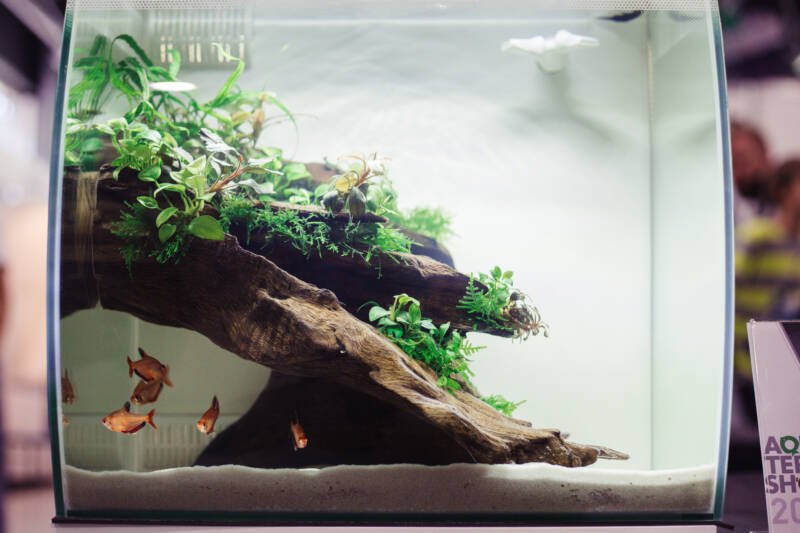
According to information collected from multiple aquarium experts, some woody plant materials are safe for the aquarium. These include:
- Alder
- Apple
- Beech
- Birch
- Cherry
- Hawthorn
- Heather
- Oak
- Pear
- Sycamore.
The idea is to find dead wood that has dried out. You don’t want to use fresh wood filled with sap. Some aquarists peel away the bark to expose the wood underneath.
The same sources recommend avoiding the following plant materials:
- Cedar
- Cypress
- Grapevine – Decays quickly
- Horse. chestnut
- Lilac – toxic to fish
- Ivy – toxic to fish
- Pine
- Spruce
- Walnut
- Yew – toxic to fish.
These woody plant materials may be safe if they sit in a bog for 50 years, but you don’t want to use them if you find them lying around on the ground.
We can’t say if these wood types are harmful or only rumored to be toxic to fish. But why take a chance when there are so many good-looking, safe wood types to use in your tank?
Where to purchase drift and aquarium wood?
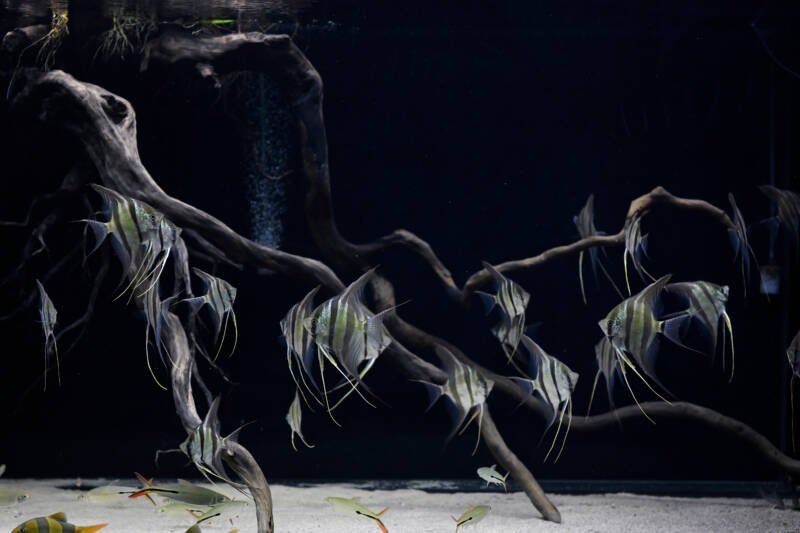
The exotic woods tend to be more challenging to find and relatively expensive. These can be found online, where specialty dealers show you the exact piece of wood along with dimensions.
These one-of-a-kind woody plant materials are coveted by serious aquascapers, especially those with larger aquariums. But if you search, you’ll find many beautiful kinds of driftwood from well-known online sellers.
Just make sure the size of the wood will fit your aquarium. Trimming may be required.
If you’re going to hunt for aquarium wood in the wild, it’s important to be familiar with what the native woody material looks like. You won’t find these branches and roots labeled as you do online.
Preparing Driftwood for the Aquarium
It’s a good idea to treat all drift and aquarium wood as if it will release tannins in the water.
Fill a plastic bin with enough water to completely cover the piece of wood. You may have to tie the wood to a rock or red clay brick if it floats. Bins with a lid are helpful because it will force the wood into the bin if it floats.
Check the water every week by scooping out a cupful. Look for yellow discoloration. Change the water every week.
Keep checking the color of the water until you are satisfied that the amount of tannin release is decreasing.
The tannins are not harmful. You just have to decide how much is acceptable to you. Soaking also makes the wood heavier and prevents it from floating.
Some aquarists boil the wood for several hours to speed up the “curing” process. You’ll need a large pot for the big pieces of wood.
Since every piece of drift and aquarium wood is different, you’ll have to experiment and see if you can cure it enough for your tank.
Other aquarists have had trouble getting one piece of wood to sink while another becomes water-logged in a week.
Tannins and pH
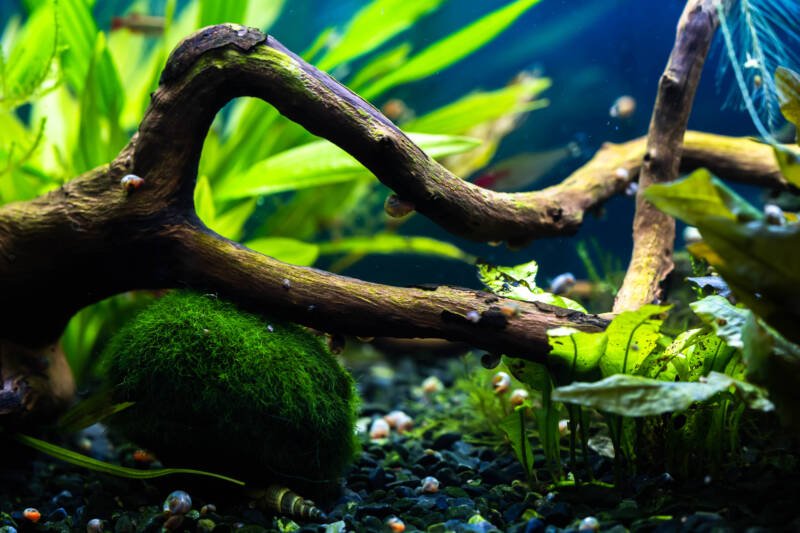
The brown tannins that seep out of some woods are often said to lower pH level.
Tannins are organic substances that have a brown color. Not all tannins lower pH. That would make handling a piece of wood a bit tricky if it was loaded with strong acids.
Nearly all woods contain natural chemicals that combine with water to form acetic acid. Acetic acid is considered weakly acidic compared to stronger sulfuric and hydrochloric acids.
It’s possible for aquarium wood to slowly lower pH only if the carbonate hardness (KH) is low to start with or reverse osmosis water is used to top off the tank.
Using water with a high carbonate hardness will keep the pH high by neutralizing the acids. Topping off the tank with high-KH water replenishes the KH and further prevents the pH from dropping.
Water with a low KH will naturally experience a pH drop over time due to the action of natural acids formed from biological filtration. Drift and aquarium wood may speed up the process by adding extra acids to the tank.
The truth is adding driftwood is not a reliable way to lower pH in an aquarium.
White Mold on Driftwood
Some woods are prone to develop a coating of water mold soon after being placed in the tank. This is a bit unsettling if you’re not ready for it.
Eventually, it will fade as the wood becomes coated with a balanced biofilm of bacteria, fungi, and other aquatic life.
You can remove the wood and boil it if the mold does not fade away naturally.
Attaching Aquatic Plants to Driftwood
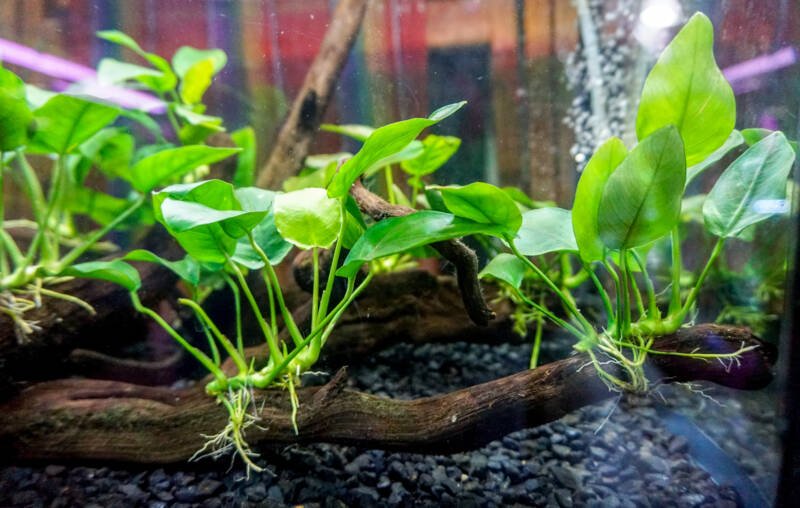
While aquarists often use bare driftwood as a focal point, it’s possible to attach live aquatic plants to the wood for a different look.
This creates a very three-dimensional appearance to the aquascape. It has also been said to make the aquascape look larger than it is. It reminds the viewer of a valley or an old tree.
If this sounds too esoteric, don’t worry.
Plants on the wood just look cool too! However, not all aquatic plants will grow on driftwood. Ferns, mosses, and certain leafy plants quite readily attach to the wood surface.
Here are a few that are easy to grow:
- Bolbitis, or African water fern, is a popular aquatic plant for wood. It has dark green, semi-translucent leaves. Attach to the wood with cotton thread until the plant takes hold.
- Microsorum pteropus is a water fern from Asia. Easy to propagate by dividing the horizontal rhizome. This is a hardy plant that grows in all conditions. Attach to the wood with cotton thread until the plant takes hold.
- Christmas moss (Vesicularia dubyana) is a native of Brazil. It looks like an evergreen tree. This slow grower will attach to wood and stones. Christmas Moss needs pruning to keep its tree-like shape.
- Anubias barteri has heart-shaped green leaves. The plant has thick roots that will wrap around branches. It should be tied to driftwood with cotton thread until the roots grasp the wood.
- Bucephalandra will grow on rocks or wood. Buce is a slow-growing plant that prefers lower light levels. It’s easy to grow. Buce is a dense plant that branches freely.
- Taxiphyllum barbieri is from South-East Asia. It’s very easy to grow and not fussy about light levels. Attach to the wood with cotton thread until the plant takes hold. It can be pruned if the plant gets too thick.
Closing Thoughts
Driftwood has been used in home and public aquarium aquascapes for over 100 years.
The great thing about using wood is that it brings a completely natural harmony to the aquascape. There is no wrong way to decorate your aquarium with wood.
The only thing to remember is to use a safe wood material and properly condition it before placing it in your aquarium. After that, the rest is up to you.
Aquascaping with driftwood is an artistic challenge with unlimited possibilities!
If you have any questions or comments, type them in below!
